Jovie
 |
KDE's tekst til tale-system, KTTS |
Hovedtræk
- Konverterer tekst til lyd
- Meget konfigurerbar
- Erstat fejludtalte ord
- Vælg talesynthesizere
- Konfigurer lyd-output
- Håndter jobs
- Kører i systembakken
- Integrerer med de fleste af KDE's applikationer
- Oplæser tekst fra klippebordet
- Oplæser hele tekstfiler eller udvalgte udsnit i Kate
- Oplæser hele HTML-sider eller udvalgte udsnit i Konqueror
- Kan bruges til bekendtgørelser (KNotify)
Beskrivelse
KDEs tekst til tale-system KTTS er en applikation, som kører i baggrunden for at oplæse tekst over hele skrivebordet. Det integrerer med mange applikationer og er enkelt at bruge.
Opsætning
Efter installation kan du starte KTTS ved at vælge i startmenuen under ; eller du kan starte KRunner (Alt+F2) og skrive
kttsmgr
. Du skal først sætte KTTS op før du kan bruge dets talesyntetisering.
Første skridt er at sikre dig, at du har en kompatibel tale-generator installeret. Følgende synthesizere er kompatible med KTTS: Festival, Festival Lite (flite), Hadifix, Epos, og FreeTTS. Enhver generator, som kan køres fra kommandolinjen kan også bruges med KTTS.
Nu kan du fortsætte med at lave en oplæser. Vælg fanebladet i kontrolmodulet og klik .
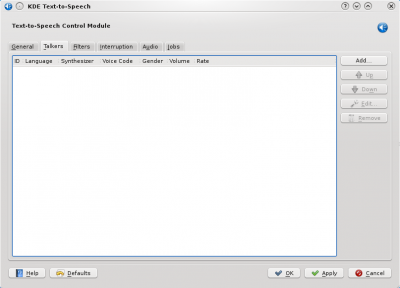
Vælg sprog og hvilken synthesizer, du vil bruge. For at bruge Festival skal du have en stemme installeret; du kan konfigurere dette bagefter ved at klikke på knappen Redigér. KTTS' skulle nu være klar. Test det ved at vælge </menuchoice>Rediger -> Test</menuchoice>.
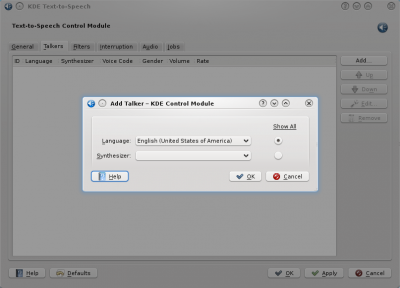
Konfiguration
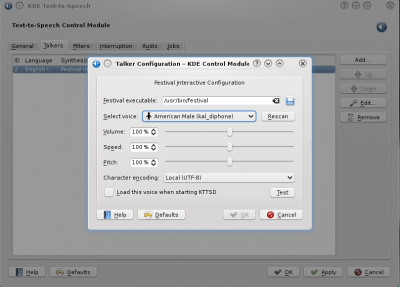
For at indstille talerens stemme, volumen, hastighed og stemmeleje går du til fanebladet , vælger oplæseren og klikker på . Et vindue som det ovenfor dukker nu op; her kan du indstille oplæseren. For at kunne ændre stemmen skal du have andre stemmer installeret.
Hvordan man bruger KTTS
System Tray
If enabled in the configuration, KTTS will be availabe to you in the System Tray. Right-clicking it will reveal the menu which is straight forward and allows for control of the speech output.
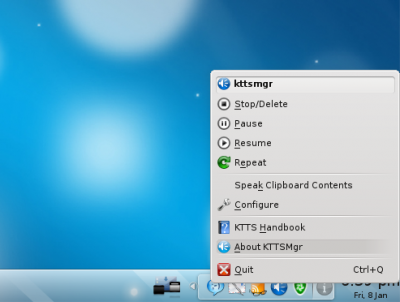
Notice the in the menu, if the application isn't integrated with KTTS (Read more about the applications with KTTS built-in in the next section) you can copy the text you want spoken, and click to hear it read.
Integration with other Desktop Applications
Konqueror
KTTS allows you to speak the text on a web page. In the menu go to . However you may not want to do this because it will also read the HTML headers on the page. Instead highlight the text you want spoken and then select .
Also note this feature is built into Okular as well. In the menu you will be give two choices or .
Notifications
KTTS works with any application that uses notifications. To set this up start an application such as Konversation that uses notifications. In the menu go to
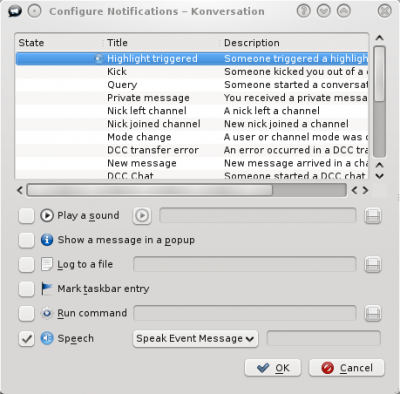
As you can see you can have various notifications for different events, such as when someone triggers a highlight. By selecting it to speak for this event it will notify you through audio output each time this event happens. Of course you can also have more than one notification.
If an application doesn't include the ability to speak text remember that you can always highlight and copy text and then use KTTS to speak your clipboard contents.
For more information check out the KTTS Handbook included with KTTS.
KTTS was renamed to Jovie during 4.5 release cycle. Thus, if you cannot find ktts package in your distribution just install Jovie.
For more information please refer to Jovie handbook.

